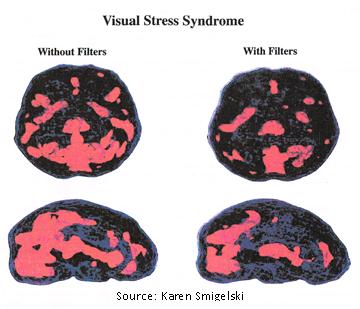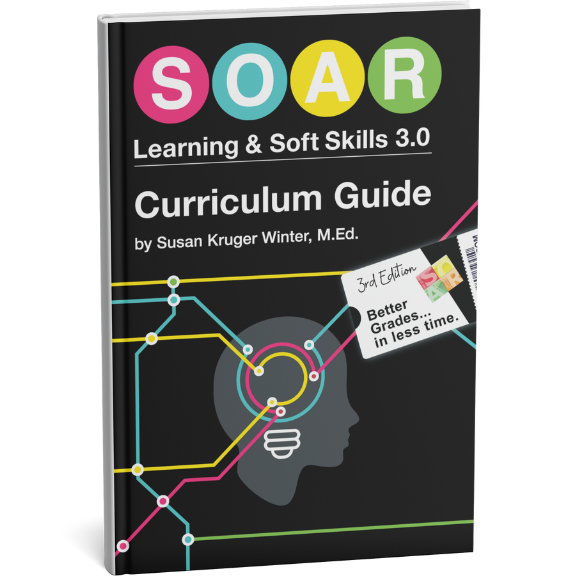The ADHD Circuit® (Article 7): A Simple Learning Solution Hiding in Plain Sight
When I was in middle school, I began to notice problems with my reading. I was having trouble seeing the text in my textbooks. When I looked at a page, I saw a glare of light slithering between the text and reflecting back at me. It was distracting and painful…like seeing a camera flash in the dark would hurt your eyes. It was constant and debilitating.
Mom took me to an eye doctor. “Everything’s fine,” he said.
But, I kept complaining.
After another year, Mom took me to another ophthalmologist. “Everything’s fine,” he said.
We had no reason to question their conclusions, but I was still troubled. I thought I was crazy. But, that didn’t stop me from complaining.
Finally, Mom took to me to a third eye doctor who had me try tinted lens glasses.
Even though they worked great, there was one “huge” problem:
The glasses had GIANT lenses with a dark rose tint. I was already a shy and self-conscious eighth-grader; there was no way I was wearing those babies outside of the house! For a while, I used them to read at home. Otherwise, I continued to suffer.
Over time, I developed coping mechanisms: One was to do my homework in extremely dim light (which I still prefer). The second, and most effective, was to avoid reading my textbooks. That did not serve my grades very well (until I learned study skills), but my eyes were grateful.
Fast forward twenty five years …
I suspected my son had dyslexia, but wanted to rule out vision issues first. We were in the midst of total chaos trying to get help for my son. So, we visited an eye doctor in our new hometown. As we talked, the doctor was excited to introduce me to a woman named Karen. Karen is a counselor specializing in education issues and was renting another office in the same complex. He gave her a call.
While the doctor did a thorough vision exam on my son, Karen came in to talk with us. “Everything looks great,” he concluded. “From what I can tell, his eyes can process everything just fine. However, I can’t tell what the brain is doing with the information it receives from the eyes.”
Karen quietly asked, “Have you had him screened for Visual Stress Syndrome?”
Karen explained that Visual Stress Syndrome causes a variety of challenges for people when they read. People with VSS complain that text appears to be moving, blurry, uneven, or flowing with “rivers of white.” Due to the physical discomfort and erratic neurological signals, some students exhibit significant behavior problems because of VSS.
I wasn’t crazy after all!
So …
What is Visual Stress Syndrome (VSS)?
L
Imagine holding a prism in sunlight and seeing all the colors of the rainbow refracting from it. This is exactly how the eyes processes light; they break light into colors and send neuron signals to the visual cortex in the back of the brain.
Researchers believe that people with VSS have optical receptors that are hyper-sensitive to certain colors of light. When the hyper-sensitive receptors are triggered, they send a surplus of electrical signals, creating an erratic pattern of activity in the brain. Maps of brain-wave activity seem to confirm this theory.
VSS is more common than people realize!
Dr. Laura Weisel, a neuro and cognitive psychologist, collected data from over 4,500 students with a wide variety of learning challenges and found that 90% of these students tested positive for VSS.
90% of students with learning challenges have VSS. 90%!
But the treatment is simple!
When I was in middle school, my eye doctor didn’t know about VSS, but she was on to something when she prescribed tinted lenses.
Recommended treatments for VSS include:
1. Glasses with tinted lenses.
2. Colored overlays/transparencies to place over reading material. (Change the background color on monitors when reading a computer screen.)
3. Colored paper for writing. Since you can’t write on a paper with a color overlay, try colored paper. The colored paper will reduce the overload of sensory input caused by white paper. This will reduce the discomfort of writing that is so common with struggling learners.
NOTE: My son recently started working with an occupational therapist to address his extreme discomfort with writing. The first thing the therapist did was test him for Visual Stress Syndrome and emphasized the importance of colored paper. She determined his best color is “blue,” so we have notebooks and special papers made with blue paper.
In about a year, the brain becomes better able to handle the additional visual input and becomes less sensitive to the glare from white paper. Our therapist Ms. Debbie explained, this period allows the “visual, vestibular, tactile, and proprioceptive systems of the body” a chance to learn how to work in sync with one another for writing. The brain becomes better able to handle the additional visual input and becomes less sensitive to the glare from white paper.
“He’ll look much more comfortable and relaxed…like he just took a deep breath and has settled into to a comfortable position for writing,” Miss Debbie explained. “When he reaches that point, you probably won’t need the color paper any longer.”
In regards to colored transparencies, I didn’t think to ask Ms. Debbie if a person could “outgrow” their need for them. I have a suspicion that they will always be helpful.
During my first year of college, after learning study skills and learning how to read “strategically”, my dependence on the visual cueing system of reading went down dramatically. Thus, reading became *significantly* more comfortable for me. However, since Karen introduced me to color overlays, I have found that my eyes do not get nearly as tired when I read. I can function just fine without the overlay, but I am much more comfortable with it.
Color sensitivity varies by individual, so each person will need to test the color overlay that works best for them. Color overlays and paper are the cheapest and fasted way to correct VSS. In some cases, a combination of two colors will be optimal. The only way to know for sure is to try them. Colored overlays are available at: irlen.com, coloredoverlays.com and howtolearn.com.
How do you diagnose VSS?
The treatment for VSS is so simple and inexpensive, I recommend that you self-diagnose by trying colored overlays to see if they make a difference. Formal diagnosis, however, is available in some areas. To find a testing center visit irlen.com or www.powerpath.com.
Oh, what a difference!
Mark prefers Eye Lighters, which are clear, tinted rulers that help him track his place in the text. They serve the same purpose as an overlay, but are more appropriate for a young second-grader. He still struggles with dyslexia, but knowing about VSS has been helpful.
90% of students with learning challenges have Visual Stress Syndrome. It commonly exists with other neurological conditions, but may exist alone. VSS causes symptoms that look like other neurological conditions. Therefore, if your child has any learning difficulty, you should screen for VSS by trying the colored overlays or consulting a professional.
Thank you to Karen Smigelski, MA, LPC, CAADC of Willow’s Edge Counseling for sharing her knowledge and resources regarding VSS.
ADDITIONAL NOTES:
• VSS should always be considered before testing for ADHD. Visual attention tests are a common tool used in diagnosing ADHD. Therefore, VSS could cause false positives for ADHD. If color overlays have been found to work effectively for a student, the overlay(s) should be used during the ADHD testing.
• Always get a thorough vision and hearing evaluation for any child who is suspected of having a learning disability. Dr. Weisel specifically suggests asking your ophthalmologist to test binocularity. Binocularity describes how well your eyes coordinate with one another. 50% students with learning challenges have binocularity problems.
Dr. Weisel has also surveyed professionals testing for learning disabilities and asked if they ever checked to see if the individuals they evaluate can see or hear. None of them do. They all assume that the individuals can see and hear just fine. This was my experience. I paid a lot of money to have my son tested for a learning disability, but I was never asked if he had hearing or vision evaluations. I scheduled those on my own.
• Fluorescent lights are a major culprit! If possible, classrooms should offer alternative lighting. Dr. Weisel suggests another alternative; in one section of the classroom, keep the lights bright. In another section of the classroom, remove one of the fluorescent tubes. In a third section of the classroom, remove two tubes. In the final section, remove three tubes. “Students will naturally gravitate to the area where they can best learn,” she says. (Taken from Learning Disabilities Study Shows Complex Issues Behind Learners’ Struggles, KET ALQ, April 2008.)
• VSS is beginning to emerge as a suspect in causing migraine headaches. If you or someone you know suffers from migraines, this would be an interesting topic to research in the next few months/years.
• The best color for overlays may not be the best color for lenses. Colored overlays change the reflection of light. Colored lenses, however, work by changing the color of the light as it enters the eye directly. This difference is subtle, but quite significant. For this reason, you must test the best lens color independently from your preferred color of overlays. (The same considerations apply to background color on a computer monitor.)
• To change the background color of your monitor on a PC, right-click on the desktop and selecting “Preferences.” From there, select “Window Color and Appearance” and test background colors from the drop-down menu.
• More information about Visual Stress Syndrome (aka Irlen Syndrome) is available at: irlen.com and powerpath.com.
For filters such as this, click on the image.
Light filters set a relaxing atmosphere for learning. Studies show that calming colors in classrooms improve students’ levels of concentration, reduce tension and anxiety, and promote positive performance
For more information about the SOAR® curriculum, please click here.
-Susan Kruger
Other ADHD Circuit® articles can be found here:
Article 1 – The ADHD Circuit® (Article 1) Introduction to the ADHD Circuit®
Article 2 – The ADHD Circuit® (Article 2): A Breakdown of the ADHD Circuit®
Article 3 – The ADHD Circuit® (Article 3): My Personal Journey Through The ADHD Circuit®. . .for a Cup of Milk!
Article 4 – The ADHD Circuit® (Article 4): ADHD Is Not an Excuse!
Article 5 – The ADHD Circuit® (Article 5): Is it Creativity…or ADHD?
Article 6 – The ADHD Circuit® (Article 6): How to Avoid the “Tasmanian Devil Tailspin” of School Work
Article 8 – The ADHD Circuit® (Article 8): “EVERYTHING Is Wrong With My Kid!”
Article 9 – The ADHD Circuit® (Article 9): Improving Social Skills
Article 10 – The ADHD Circuit® (Article 10) When ADHD Children have ADHD Parents
JL041315
Six Steps
Conquer the Chaos
Get Our Free Guide & Information on...

"*" indicates required fields
Get Our FREE Curriculum Guide!
The SOAR® Curriculum
The most critical learning, organizing, and communication skills needed for school. Learn more here.
Who’s Using SOAR®?
SOAR® Guarantee
Click here to learn more.





